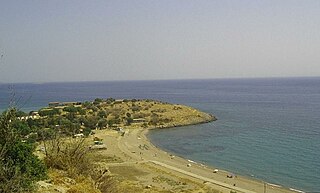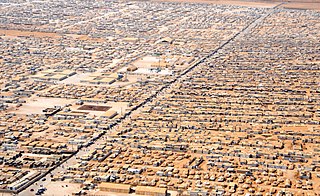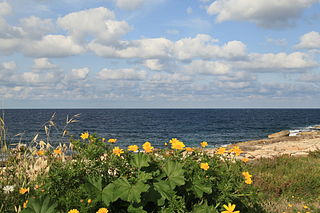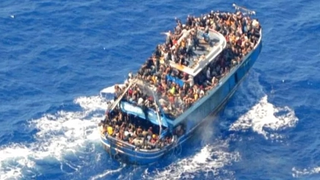
This is a demography of the population of Lebanon including population density, education level, health of the populace, economic status, religious affiliations and other aspects of the population.
Palestinian refugees are citizens of Mandatory Palestine, and their descendants, who fled or were expelled from their country, village or house over the course of the 1948 Palestine war and during the 1967 Six-Day War. Most Palestinian refugees live in or near 68 Palestinian refugee camps across Jordan, Lebanon, Syria, the West Bank and the Gaza Strip. In 2019 more than 5.6 million Palestinian refugees were registered with the United Nations.

The Lebanese Navy is the naval warfare of the Lebanese Armed Forces. Formed in 1950, it traces its heritage to the maritime civilization of Phoenicia; its flag depicts a Phoenician ship with the Lebanese Cedar tree, positioned on an anchor above the Arabic inscription of the navy's name. Headquartered at Beirut Naval Base, Lebanon's first and largest naval base, the navy has posts Tripoli, Saida, and Tyr.

On 27 March 2009, at least one boat carrying migrants from Libya to Italy capsized. The boat is believed to have been carrying 250 migrants from Egypt, Tunisia, Palestine and Nigeria. A rescue attempt involving the Italian and Libyan navies rescued 21 survivors from the boat and retrieved 21 bodies. A further 77 bodies subsequently washed up on the shores of Libya before rescue efforts were called off. Two other boats also went missing between Libya and Italy, carrying around 250 more people between them. A fourth boat, carrying 350 people, was rescued by an Italian merchant ship on 29 March in the same area of sea.

The 2009 Sierra Leone ferry accident occurred on 8 September 2009 off the coast of Sierra Leone, when a wooden Teh Teh ferry travelling from Shenge village to Tombo sank during a storm. At least 90 people to date have been confirmed dead, and over 100 others have been listed as "missing". So far, only 39 survivors have been rescued. Several of the passengers were children who had been on holiday, though the official passenger manifest did not include them. An attempted rescue operation ended on 11 September. The sinking is the worst such accident in Sierra Leone since 2002, when a boatful of refugees capsized. The Xinhua News Agency in China has likened the disaster to other major marine accidents in recent years.

The December 2007 Seferihisar, Turkey migrant boat disaster occurred in the night of 8 December 2007 when a 15-meter dinghy boat carrying illegal migrants who were trying to reach the island of Chios, Greece, capsized due to bad sea conditions off the coast of Seferihisar, İzmir Province, western Turkey, resulting in forty to sixty deaths, sources varying on the exact number of casualties, among the boat's occupants. It is the single largest maritime incident in terms of loss of lives and involving migrants in the Aegean Sea.

On 6 April 2011, a boat carrying migrants from Libya to Italy sank 32 nautical miles south of Lampedusa and 96 nautical miles southwest of Malta. An emergency response involving the Italian Coast Guard resulted in the rescue of an initial 48 survivors and the retrieval of 20 bodies. A fishing boat picked up an additional three survivors. At least a further 130 people were not found after the shipwreck.

Syrian refugee camp and shelters are temporary settlements built to receive internally displaced people and refugees of the Syrian Civil War. Of the estimated 7 million persons displaced within Syria, only a small minority live in camps or collective shelters. Similarly, of the 8 million refugees, only about 10 percent live in refugee camps, with the vast majority living in both urban and rural areas of neighboring countries. Beside Syrians, they include Iraqis, Palestinians, Kurds, Yazidis, individuals from Somalia, and a minority of those who fled the Yemeni and Sudanese civil wars.
On 3 October 2013, a boat carrying migrants from Libya to Italy sank off the Italian island of Lampedusa. It was reported that the boat had sailed from Misrata, Libya, but that many of the migrants were originally from Eritrea, Somalia and Ghana. An emergency response involving the Italian Coast Guard resulted in the rescue of 155 survivors. On 12 October it was reported that the confirmed death toll after searching the boat was 359, but that further bodies were still missing; a figure of "more than 360" deaths was later reported.
Syrians in Lebanon refers to the Syrian migrant workers and, more recently, to the Syrian refugees who fled to Lebanon during the Syrian Civil War. The relationship between Lebanon and Syria includes Maronite-requested aid during Lebanon's Civil War which led to a 29-year occupation of Lebanon by Syria ending in 2005. Following the outbreak of the Syrian Civil War, refugees began entering Lebanon in 2011.

In September 2014, it was announced by the International Organization for Migration that a ship sank off the Malta coast on September 11, 2014, killing around 500 migrants. There were eleven survivors. The ship left Damietta, Egypt, on September 6 and sank five days later on September 11. Two Palestinian survivors of the wreck accuse the traffickers of intentionally sinking the vessel after the refugees would not agree to transfer to a different ship.

This is a timeline of the European migrant crisis of 2015 and 2016.

On September 21, 2016, a boat capsized off the Egyptian coast with around 600 refugees on board in the Mediterranean Sea. 204 bodies were recovered, around 160 people were rescued, and hundreds of people remain missing, with approximately 300 people presumed dead. Four people were arrested for trafficking and breaking capacity laws. The incident was the worst in 2016 in the Mediterranean Sea.

2018 Libya migrant shipwrecks began on January 9, 2018, when up to 100 migrants went missing as their migrant rubber boat was punctured and sank off Libya's coast.
On 26 February 2023, a boat carrying migrants sank amidst harsh weather conditions while trying to land on the coast of Steccato di Cutro, a seaside resort village near the town of Crotone in the region of Calabria in Southern Italy. The boat was carrying about 200 migrants when it sank, of whom at least 94 died, including at least 35 children. Eighty-one people survived.

On 14 June 2023, the Adriana, an Italy-bound fishing trawler smuggling migrants, sank in international waters in the part of the Mediterranean known as the Ionian Sea, off the coast of Pylos, Messenia, Greece. The boat had a capacity of 400 people, carried an estimated 400 to 750 migrants, mostly from Pakistan, Syria, Palestine, and Egypt, and some from Afghanistan. After departing from Tobruk, Libya, on 10 June, concerns were raised by 13 June, with the vessel then located in the Maritime Search and Rescue (SAR) zone assigned to Greece. The Hellenic Coast Guard (HCG) helicopter and later the HCG vessel ΠΠΛΣ-920 arrived on scene, took aerial photos of the vessel, made offers of assistance that were allegedly refused, then by some accounts remained there as an observer until the boat capsized and sank, despite calm weather conditions. After the Adriana had sunk "close to the deepest part of the Mediterranean Sea", the HCG and the military initiated a massive search and rescue operation. One hundred and four men were rescued, and 82 bodies were recovered. By 18 June, officials had acknowledged that over 500 people were "presumed dead."

On April 22, 2021, a boat carrying around 130 migrants of sub-Saharan origin sank off the coast of Libya. The disaster led to the death of all the people sailing on the small boat.













